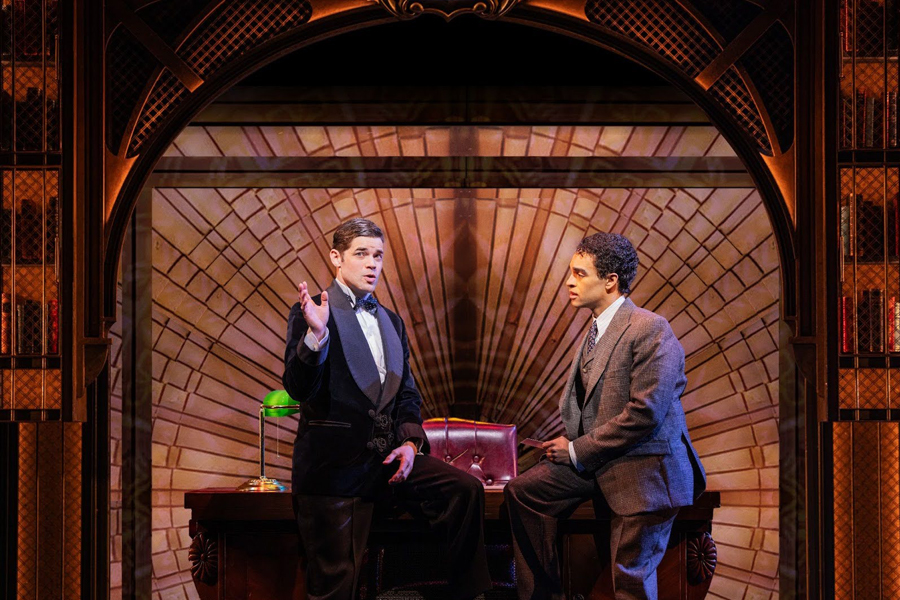
From Page to Stage: Adapting The Great Gatsby for Broadway
Scott Fitzgerald's The Great Gatsby, a cornerstone of American literature, vividly captures the Roaring Twenties through themes of wealth, love, and the American Dream. Now adapted into a Broadway musical, this classic story has found a new life on stage. Let’s delve into the creative process behind reimagining this timeless tale, exploring the music, staging, and enduring appeal that continues to enthrall audiences.
Crafting a Theatrical Journey: Adapting The Great Gatsby
One of the greatest challenges when bringing The Great Gatsby to life on stage was capturing the spirit of Fitzgerald's world while crafting a production that stands on its own, perfect for both fans of the novel and complete newbies.
Another major challenge was translating the novel's intricate narrative and rich prose into a visual and auditory experience. The novel is renowned for its detailed descriptions and internal monologues, which are often difficult to convey on stage. The creative team had to find innovative ways to portray these elements, using music and visual effects to capture the novel's mood and themes.
Additionally, there was a need to balance the expectations of audiences familiar with the book with the demands of a live performance. Fans of the novel have strong attachments to Fitzgerald's characters and story, so any adaptation would need to respect the source material while offering something new and engaging.
Assembling The Great Gatsby’s Creative Team
The Great Gatsby brought together a creative team led by director Marc Bruni. Book writer Kait Kerrigan was responsible for adapting the novel's narrative into a script that worked for the stage and carefully translating Fitzgerald's prose into dialogue and scenes that capture the essence of the story while flowing naturally in a theatrical setting.
Music is central to any Broadway show, and composer Jason Howland was tasked with creating a score that reflects the novel's themes and time period. The music needed to evoke the Jazz Age, capturing the energy and emotion of the 1920s while supporting the story's dramatic arcs. Dance is another critical element of any musical, and choreographer Dominique Kelley worked to incorporate 1920s dance styles into the show to bring an authentic flair.
Bringing the Story to Life
Pre-production for The Great Gatsby involved reimagining its narrative to fit the dynamic world of musical theatre. The adaptation process began with distilling the novel's complex story into a format that could work within the confines of a stage production. This meant condensing the sprawling narrative into key scenes that capture the book's essence. The challenge was to retain the novel's spirit while ensuring that the story unfolds seamlessly in front of a live audience. The adaptation focused on the core plot points and characters, including the iconic Jay Gatsby, Daisy Buchanan, and Nick Carraway, translating the novel's intricate social dynamics and emotional tensions into clear, engaging scenes.
The show’s central themes, such as the pursuit of the American Dream and the clash between illusion and reality, are just as prominent in the Broadway show as in the original novel. The adaptation weaves these themes into the very fabric of the production through song, dialogue, and even staging, exploring the characters' dreams and disappointments.
To Broadway and Beyond
The Great Gatsby finally got its world premiere at the Paper Mill Playhouse in Millburn, New Jersey. With previews commencing on October 12, 2023, and an official opening night on October 22, this initial production quickly captured the attention of theatre enthusiasts and critics alike. The show’s compelling portrayal of F. Scott Fitzgerald’s characters and its jazz-infused score sparked a buzz that reverberated all the way to Broadway.
The production made its much-anticipated transfer to the Broadway Theatre, with previews beginning on March 29, 2024, and a grand opening on April 25, 2024. This transition marked a significant milestone, as the timeless tale of Jay Gatsby's pursuit of the American Dream found a new home at one of the most famous theatres in the world. The production's success did not stop there, as plans were set in motion for its European premiere in London's West End in the spring of 2025.
The Music of The Great Gatsby
The score of The Great Gatsby perfectly captures the feel of the Jazz Age, with rhythms and melodies that evoke the energy and style of the 1920s. But if jazz is not your thing, don’t worry - the creative duo of Jason Howland and Nathan Tysen made sure to add plenty of modern influences for 21st-century audiences.
Each character is given a distinctive musical voice, with songs that reveal their inner thoughts and desires. While Jay Gatsby's solo “For Her” reflects his longing and idealism, Daisy’s songs “For Better or Worse” and “Beautiful Little Fool” express her inner conflict.
The grand party scenes at Gatsby's mansion are transformed into lively musical numbers, highlighting the extravagance of the time period. Numbers like “Roaring On” bring to life the opulence and chaos of Gatsby's gatherings, illustrating the contrast between appearance and reality. The orchestra adds to the magic with its dynamic presence; positioned prominently on stage during the party scenes to add to the visual spectacle.
Experiencing The Great Gatsby on Broadway offers a unique opportunity to see this classic story in a new light. Whether you've enjoyed the book or are a newcomer to the story this musical invites you to step into the world of The Great Gatsby and witness some of the best live theatre has to offer.






